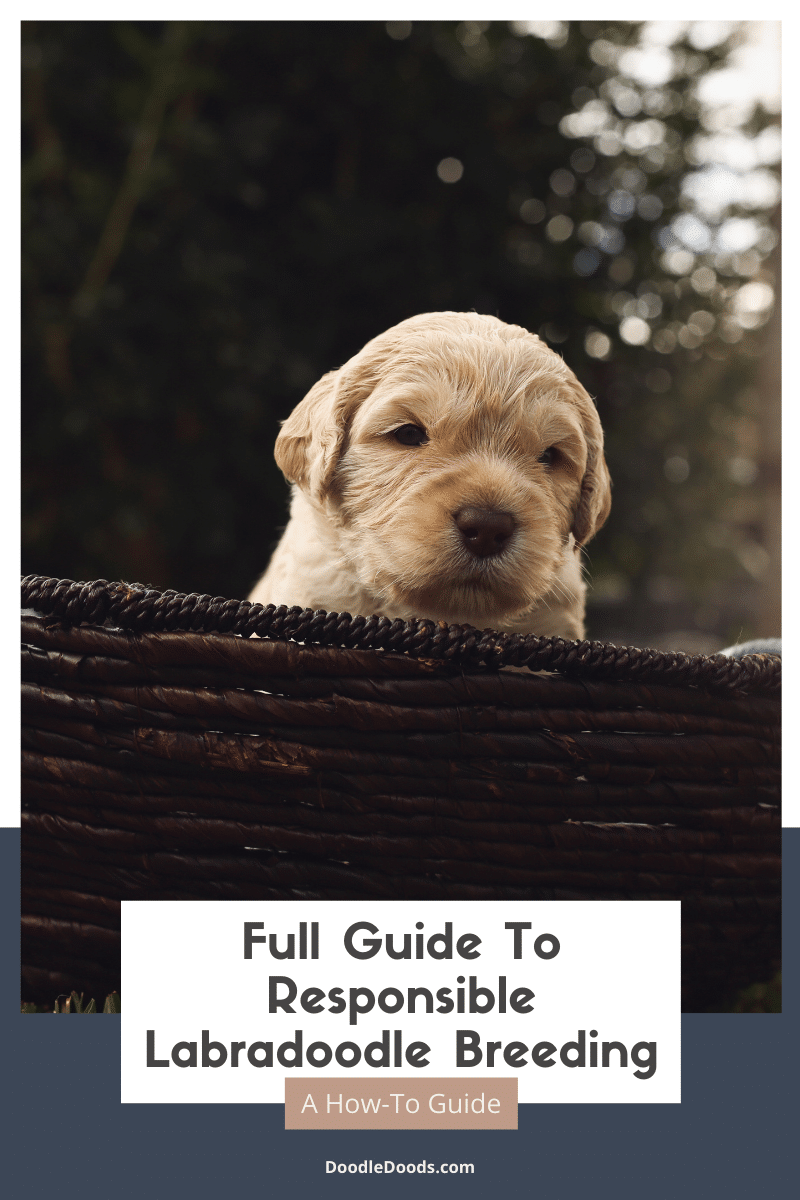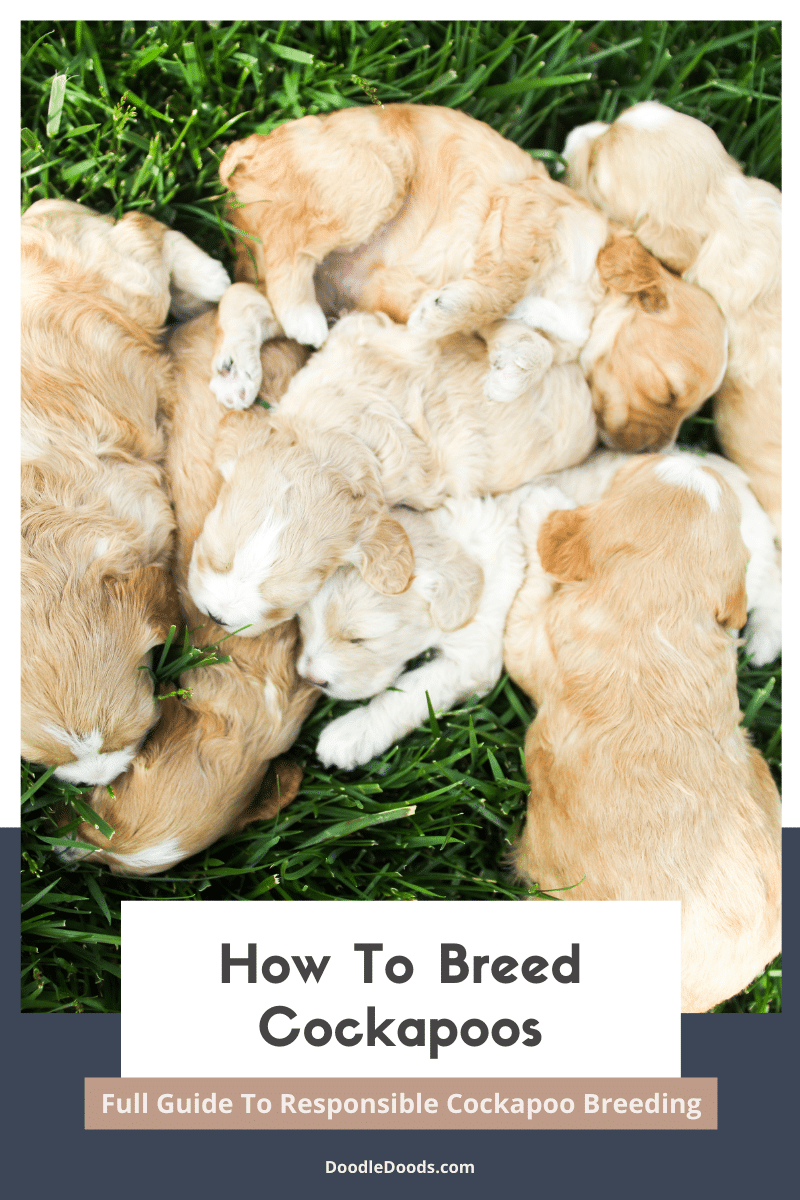Labradoodles, a wonderful cross between the family-favorite Labrador Retriever and intelligent, hypoallergenic Poodle, are increasingly in-demand dogs. If you’ve already taken one of these pups on, you too may have fallen under their spell to the point where you may be considering breeding your pup so that others can know the gift of owning one of these delightful dogs. Otherwise, you might have been thinking about getting into the Labradoodle breeding game for a while and would like to have an idea of what to expect.
However, there’s a bit more to breeding your dog than just the (ahem) “getting down to it” part. Here we’ll cover the basics of what it takes to be a responsible Labradoodle breeder, so whether you’re looking to breed a single litter or make a career from it, you’ll know a little more about what you’d be getting yourself into if you did decide to take the plunge.
Table of Contents
- Labradoodle Breeding: A Quick Word of Caution
- Labradoodle Breeding Checklist
- 1. Health & Genetic Screening
- 2. Generations & Sizes
- 3. Federal Licensing & USDA Standards
- 4. Choosing A Suitable Mate
- 5. Mating & Pregnancy Care
- 6. Setup, Equipment, & Supplies
- 7. Birthing, Rearing The Puppies & Weaning
- 8. Training, Socialising & Extra Services
- 9. Advertising The Puppies & Social Media
- 10. Following Up With The Families
Labradoodle Breeding: A Quick Word of Caution
Before getting too caught up in the excitement of puppies, you need to be aware that breeding any kind of dog – even mixed heritage ones – is no walk in the park. There’s a lot to educate yourself about the process before you even start to think seriously about doing it. If you don’t do the research ahead of time, you’ll likely find yourself with more work (not to mention more expenses) on your hands than you could have anticipated. You may even unwittingly end up joining the ranks of the dreaded ‘backyard breeders.’
While not quite as bad as the puppy mills, where animals are bred and bred and bred with profit rather than their welfare in mind, backyard breeders find themselves doing wrong by their pets and the litters created simply because of a lack of knowledge and experience. While, as an animal lover devoted to your pets, you’ll want to avoid this at all costs for your dog’s sake, you should also know that the resultant puppies will be hard to shift as you won’t be able to offer the same kind of health assurances as other breeding facilities.
That being said, if you already have some understanding of breeding puppies the right way and you are determined to discover the rest ahead of time, it could very well be one of the best experiences you have. Otherwise, you might well turn the concept into a fulfilling (not to mention lucrative) career. There’s no doubt that Labradoodle popularity is rising by the day. Happily, this is playing its part in boosting the breeding standards of these dogs, so breeders today have more insight into creating only happy and healthy puppies.
Labradoodle Breeding Checklist
Here are a few of the areas you’ll need to do a little more reading up on prior to deciding whether you are going to breed your Labradoodle – or not!
1. Health & Genetic Screening
While it can be easy to focus on ensuring you end up with the cutest puppies so that people will want to adopt them, when you commit to breeding dogs – any kind of dog – your main aim needs to be ensuring that the resulting puppies are healthy above all else. As most common canine conditions are heritable (inherited from one or both parents), the first thing you need to do is check that each parent pup is not only in the best current condition but that they aren’t carrying any nasty genes that they could pass onto their offspring.
Doodles, as mixed-breed dogs, benefit from hybrid vigor, meaning that their more diverse genes make it less likely for them to end up with certain genetic disorders. However, to eliminate the risk entirely, you’re going to need to fork out for comprehensive (expensive) genetic tests. This is something that prospective pet parents are increasingly clued up about, and it’s likely to be something your buyers do ask you about. So you’ll not only need to let the vet do their thing, but you’ll need to have a decent understanding of it all too.
2. Generations & Sizes
While health will be your top priority, you will also want to be sure that the puppies you breed can very easily find homes. This is where it pays to know about all the different types of Labradoodles and to do a little research to see precisely what people are after. For instance, Labradoodles come in varying sizes: Toy, Mini, Medium, Standard, and Giant, and the smaller ones, being seen as more manageable, are often the most desirable. This means that not only are they easier to find homes for, but you can usually charge more.
Another common reason people opt for a Doodle is their low-shed, so-called “hypoallergenic” properties. Whether this is because they have pet allergies or simply because they don’t relish the idea of vacuuming on a daily basis. However, not all Labradoodles inherit this particular trait from their Poodle parents. Some actually end up with the much higher-shedding Labrador Retriever coat. The issue here is that genes are pretty tricky, and it’s tough (even for the experts) to know how they will be expressed.
In response to this, breeders have been working on different “generations” of Labradoodle based on whether they want to increase the possibility of their puppies inheriting Poodle appearance and personality characteristics over Labrador Retriever ones or vice versa. For instance, rather than having one parent dog of each breed, they will backcross a Labradoodle with a Poodle, for instance, upping the Poodle genetics in these puppies. These different dogs are referred to as F1, F1B, F1BB, F2, F2B, F2BB, and F3 (multigen).

3. Federal Licensing & USDA Standards
Depending on the kind of breeding you’re looking to do, the number of animals you have, and whether you’re looking to turn this into a commercial venture, you may need to register your “breeding facility.” Exactly how you go about doing this will depend on where in the country you are situated. Dog breeding is regulated on a federal level. Once they reach a certain level of operation, these kinds of businesses are inspected to ensure they operate within the required standards outlined by the USDA.
For smaller-scale breeders, there might not be any official regulating bodies. However, as Doodles are becoming as popular as pedigree dogs, voluntary organizations are popping up to better help consumers know which facilities they can trust – or not. Good Dog is one such example. While not Labradoodle-specific, they evaluate breeders based on meeting certain breeding standards before recommending them on their site. Breeders seeking such memberships are likely to take the health of their animals far more seriously.
4. Choosing A Suitable Mate
A breeder should never base the decision on a suitable mating candidate solely on appearance. Cute dogs may equal cute puppies, but there are many other factors to consider when finding the best mating pair. A rudimentary knowledge of genetics and how these might play out is essential for this stage. You’ll not only need to think about what size and generation the puppies will be, but you’ll also have to be aware of what the pairing will mean in terms of both the puppies’ temperament and their health.
When looking to breed your female dog with a pedigree – either a Poodle or a Labrador Retriever, you’ll need to ensure that they are officially registered to evidence the fact that they are purebreds. If you are combining your dog with another Labradoodle, you’ll have to have a strong understanding of what breeds comprise their makeup – are they first or later generation? What sizes of Poodle were used? What coat types are in the mix? Discerning buyers are likely to have a lot of questions about what they might expect from their dog.
You’ll also want to factor in personality traits – finding a dog that strengthens the weaknesses of your pup while not bringing too many of their own issues into the mix. Beyond that, you’ll need to be sure that both pups are in peak condition. This goes doubly for the female. Pregnancy, whelping, and nursing are highly physically and psychologically demanding. If your hound is not entirely healthy, or if they are too young or too old, then you could have some serious (and very costly) problems on your hands.
5. Mating & Pregnancy Care
Before breeding your dogs, if working with another owner, you’ll need to organize a stud contract. This may involve a cash fee and/or pick of the litter. Either way, it’s good to have the terms of this worked out in advance. Both dogs will need a pre-breeding physical check-up to be sure they are disease free, that they have reached sexual maturity, and that they are fertile. Males tend to get this stage around 12 to 15 months, whereas, for females, it might be somewhat later. A female dog should not be bred in their first season.
Once you have established a suitable time during your dog’s cycle that they will accept the male, you’ll need to mate them two or three times to be sure you hit the peak fertile period. Be sure you’re clued up on all the steps of dog breeding – certain parts of it can seem a little confusing if you have never seen them before! Be aware also of the signs of pregnancy, which can include an increase in appetite, weight, and nipple size. A vet can confirm this at around 28 days. You should chat with them about what to expect now.
Canine gestation lasts approximately 63 days, and during this time, your dog will have very specific nutritional needs. Switching them over to a kibble specifically designed to meet these needs, especially during the latter days of their pregnancy, is your best bet. Be sure not to overfeed your dog thinking that she must eat much more than usual at this time. Obesity can up the complications faced during whelping, making it more likely that she will have a prolonged labor and places extra stress on the birthing puppies, too.
6. Setup, Equipment, & Supplies
Aside from having the right kind of food for mother and later for the puppies on hand, there are plenty of other purchases to be made before you can consider yourself fully prepared for breeding a litter. You’ll need to set up a suitable space with a whelping box to keep the puppies safe in their earliest days. It needs to be large enough for movement yet snug enough so the puppies can’t venture too far away from mom. It must also be warm and comfortable with a waterproof base and absorbent, easy-to-clean bedding.
If you live in a cooler climate, chances are you will also need a heat lamp or heating pads. Puppies are unable to regulate their temperature in their earliest days and will need to be kept warm. You’ll also need to put together a whelping kit that will include (among other things) a bulb syringe used to suction and clear the mouths of the newborns, round-tipped scissors in case you need to cut any of the umbilical cords, a hemostat to crimp them first and prevent excess bleeding, and unwaxed dental floss for tying them off after cutting.
7. Birthing, Rearing The Puppies & Weaning
A few days before your dog gives birth, you may notice them nesting. Signs of labor include your dog panting, straining, and appearing restless. The puppies should appear pretty shortly following this. Most dogs can handle this stage well without any human intervention needed, but it’s still a good idea to keep an eye out for any potential problems. Have your vet’s number to hand, as well as the details of your nearest emergency clinic. This process, known as whelping, takes somewhere in the region of 3 to 12 hours.
Once the puppies are born, the mother should take care of the rest. Just be sure to check that she is feeding them and keeping them warm enough. Limit how much you handle them during this time. It’s good to be aware that some mothers aren’t able to produce enough milk to feed all her puppies – especially if there are a lot of them, so you may be faced with having to hand-rear them. Cow’s milk is not a suitable alternative, so a commercial puppy formula is recommended for this, and you will need to do it often.
As you notice the puppies start to grow, it’s a good idea to keep a record of their weight to check that they are maturing at the right speed. This will tell you that they are healthy and getting enough food. Weaning begins when the puppies are around two to four weeks of age. This is when the puppies need to be shifted onto solid food to ensure that they are getting all the nutrients they need to support their moving-towards-more-rapid growth. During this time, you’ll also be chatting with your vet about deworming, microchipping, and vaccinations.
8. Training, Socialising & Extra Services
Many people looking to take on the responsibility of a new puppy have never done so before. That’s why many of the better breeders do everything they can to support both the puppies and their new families with the transition to their new home. Getting the dogs used to be handled by different people is an integral part of this, as is introducing them slowly and carefully to children and other animals. This is a vital part of their earliest socialization and will help with setting them up to have more confidence in novel situations.
Some breeders will also make a start on toilet training during these first eight weeks – and that can really make all the difference for newbie owners. This will include encouraging them to go to the potty in certain areas only, such as on a puppy pad. The benefit of doing this while the puppy is still with mom and their siblings is that it will be the mom who first encourages the puppy to leave the sleeping and eating areas to do their business. This is the most natural way and will happen within the first two or three weeks of the puppy’s life.
As breeders are often considered to be among the most experienced dog owners – and so professionals in all areas of dog care, buyers frequently rely on them for advice. Positioning yourself as an expert in your field by having a thorough understanding of puppy training concepts such as early neurological stimulation (ENS) and being registered with programs like the Badass Breeder Puppy Curriculum will make your puppies that much more popular. You’ll also be able to offer additional training services at an extra cost.
9. Advertising The Puppies & Social Media
With the rise of scammers and puppy mills in the Doodle-sphere, not to mention the ever-increasing price of these dogs, people are becoming more cautious about whom they buy from. That’s why it’s vital for you to have a solid online presence to reassure potential buyers that you are what you present yourself as being. Most people will want to be able to peruse a professional-looking website with thorough details of the breeding dogs (with their health and genetic information) and learn more about your breeding philosophies.
Social media plays a large part in this too, and it’s a great way to reach out to people who are potentially interested in purchasing a puppy. Photos, videos, daily accounts of the puppy, and testimonials from previous customers will all help with establishing your place in the breeding community as well as with helping prospective pet parents know that they can trust you, your operation, and the health of the puppies you are breeding. Keeping this all up and running can be far more time-consuming than you might think.
Once you have found potential families for your puppies, you’ll need to carefully screen them. Responsible breeders want their puppies to end up in the best, most suitable homes possible. This can sometimes be tricky to gauge based on the information you may have about the individual. For this reason, you’ll need to come up with a thorough and effective home evaluation process that takes a look at the environment the puppy will be raised in, the knowledge of the family, and ensure their lifestyle is suitable for owning a Labradoodle.
10. Following Up With The Families
With all that out of the way and the puppies firmly established in their new situations, it would be understandable that you might consider your work to be done. Not so! Beyond being responsible for any health guarantees provided with your puppies (the gold standard in showing you have faith in the good health of your puppies), you’ll need to be prepared to address any follow-up questions about your animals. The responsibility you have for the puppies that you brought into this world doesn’t end when they leave your home.
In fact, the very best breeders invest in their dogs for life. They are ready and prepared with information, resources, product recommendations, training tips, and more, not just for the puppy but the adolescent and even the adult dog they become. You will likely be rewarded for your ongoing support with glowing reviews, photos, and frequent updates of your pups and any offspring they have. In this way, you’ll be able to keep track of your breeding lines and know that you are producing the very best Labradoodles you can.
If you are thinking of breeding your Labradoodle male or female – whether just the once or on a more ongoing basis – there are plenty of preparations to be made. This includes having a fair understanding of what to expect both in terms of the process and the kinds of puppies that will result from the pairing. Hopefully, the information covered in this article, while by no means exhaustive, has provided you with an introduction to the topic and has given you a firm basis for your future research with regard to setting yourself up as a responsible breeder of Labradoodles.
Learn How to Care for Your Doodle Puppy!

Perfect for first-time Doodle parents, get ALL your questions answered, including questions new Doodle parents don’t even think to ask.
Plus, get $700 worth of Bonus Materials for FREE, including:- Doodle Parenthood Community and Support Group ($190 value)
- Doodle Puppy Growth Tracker ($20 value)
- EMERGENCY Cheatsheet: When To Call The Vet Immediately ($50 value)
- HELP! Button ($145 value)
- And SO MUCH MORE!











